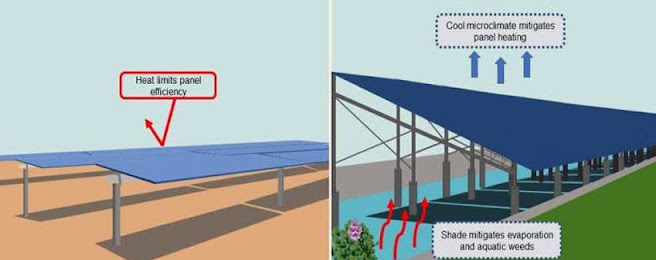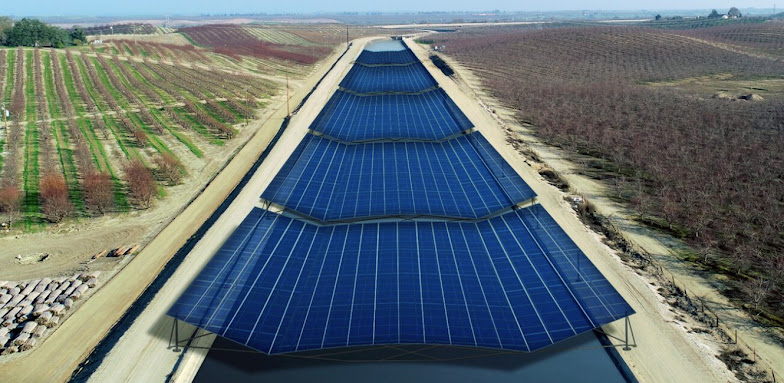 |
| A solar canal system for California, as depicted by an artist. Solar Aquagrid LLC, CC BY-ND.- Credit |
Roger Bales is an engineer who has been working with colleagues on a plan to secure water supplies while also increasing renewable energy production to help the environment.
The solar-canal method is being tried in California right now.
Water is delivered to 35 million Californians and 5.7 million acres of farmland via over 4,000 miles of canals. Covering these canals with solar panels, as we explained in a 2021 study, would prevent the evaporation of precious water—one of California's most valuable resources—while also helping the state reach its renewable energy targets and save money.
The very first models for both wide-span and narrow-span canals in the United States are now being developed in California's Central Valley. Researchers from the University of California, Merced, are working on the project, and we will try to figure out how to make this a large-scale solution.
Water and land preservation
Drought is a regular phenomenon in California, and water is a persistent source of concern. Climate change is generating hotter, drier weather.
In the last 10 to 30 years, drought has dried outwells, led officials to adopt water restrictions, and sparked massive wildfires.
California, on the other hand, has lofty conservation goals. The state has the mandate to limit groundwater pumping while ensuring that farmers, cities, wildlife, and ecosystems have reliable supplies. Governor Gavin Newsom authorized the California Natural Resources Agency to spearhead efforts to save 30% of land and coastal waters by 2030 as part of a larger climate change program in October 2020.
During the winter, the majority of California's rain and snowfalls are north of Sacramento, whereas the state's water use is focused in Southern California, primarily during the summer. This is why the state's canal system is the world's largest. Under the hot California heat, we estimate that around 1% to 2% of the water they carry evaporates.
 |
| Installing solar panels over canals improves the effectiveness of both systems. Photographer: Brandi McKuin - Image Credit |
Solar panels strewn across California's canals would generate a significant amount of electricity. According to our calculations, it could supply 13 gigawatts of renewable energy capacity, which is over half of the additional sources the state needs to reach its clean energy objectives of 60% carbon-free by 2030 and 100% renewable by 2045.
Solar panels installed over the canals improve the efficiency of both systems. The solar panels would reduce evaporation from the canals, which is especially important during the hot months in California. Because water heats up slower than land, the canal water flowing beneath the panels might cool them by 10 ℉, increasing power output by up to 3%.
In many areas of California, these canopies might also generate electricity locally reducing both transmission losses and customer costs. Solar power combined with battery storage can aid in the construction of microgrids in rural and underserved areas, making the power supply more efficient and robust. This would reduce the likelihood of power outages caused by harsh weather, human mistake, or wildfires.
Researchers believe that covering canals with solar panels will be more expensive than installing ground-mounted systems. However, when we included in some of the co-benefits, such as avoided land expenses, water savings, aquatic weed abatement, and improved PV efficiency, we discovered that solar canals were a better investment and delivered power at a lower cost over the solar systems' lifetime. And that's before we consider the benefits of improved air quality and lower greenhouse gas emissions to public health.
Land-based benefits
Solar canals are about a lot more than just generating renewable energy and conserving water, to be sure. The construction of these long, thin solar arrays could avert the conversion of more than 80,000 acres of cropland or natural habitat for solar farms.
California supplies more than 50% of the fruits, nuts, and vegetables consumed in the United States, feeding an ever-increasing worldwide population. However, agricultural lands, including significant swathes of fertile farmland, may house up to 50% of new renewable energy generation needed to satisfy decarbonization goals.
Solar canals will also safeguard wildlife, ecosystems, and culturally significant terrain. Large-scale solar projects can lead to habitat loss, degradation, and fragmentation, putting endangered animals like the Mojave Desert tortoise at risk.
They can also impact desert-scrub plant groups, particularly flora with cultural significance for Indigenous nations. The Genesis Solar Energy Center, for example, was built in the Sonoran and Mojave deserts between 2012 and 2014, destroying paths and burial sites as well as damaging important cultural items, resulting in a protracted legal battle.
 |
| A solar canal as imagined by an artist. Photo courtesy of Robin Raj, Citizen Group, and Solar Aquagrid - Image Credit. |
Taking care of the weeds as well as the air.
Solar canals can enhance air quality by creating clean electricity.
Another advantage is the reduction of aquatic plants that clog canals. Shade from the panels reduces the growth of weeds that clog drains and hinder water flow in India, where developers have been installing solar canals since 2014.
Herbicides endanger human health and the environment, thus combating these weeds is expensive. We estimate that shading canals would save around US$40,000 per mile for large, 100-foot-wide canals in California. Savings of up to $69 million per year could be realized over the entire state.
Solar canals are being brought to California.
The old electricity infrastructure in California has contributed to catastrophic wildfires and multiday outages. Smart solar installations on canals and other disturbed areas can improve power and water infrastructure while saving water, lowering costs, and combating climate change.
In cooperation with project developer Solar Aquagrid, researchers, and others, the Turlock Irrigation District in California's San Joaquin Valley will construct the first solar canal prototype, which will be supported by the state Department of Water Resources.
The prototypes in this mile-long demonstration project, as well as future pilots, will assist operators, developers, and regulators in refining designs, assessing co-benefits, and evaluating the performance of these systems. We can plan out options for extending solar canals statewide, and even across the West, with more data.
Source: The Conversation, Tech Xplore









0 Comments
please do not enter any spam link in the comment box